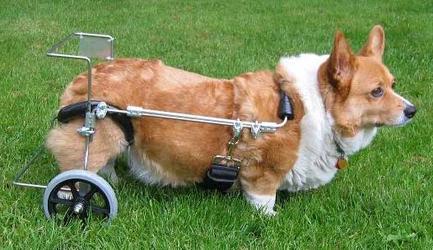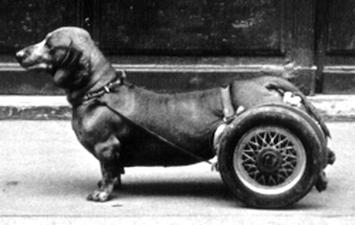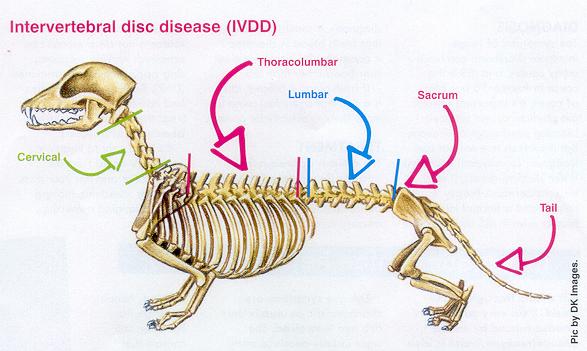by Veterinary Mark Elliott
IVDD - also known as a prolapsed, ruptured or slipped disc(s) - is a common problem seen mostly in dwarfed breeds with normal trunks and shortened extremities. These include the Dachshund, Pekingese, Shih Tzu and Lhasa Apso.

Unfortunately also Corgis are prone to IVDD
The Dachshund has by far the highest breed incidence, with a risk for IVDD that is 10-12 times higher than that of any other breed.
The spine is comprised of several vertebrae, which make up the bony column that supports and protects the spinal cord. An intervertebral disc separates adjacent vertebrae, and its role is to cushion the spine and increase flexibility. Intervertebral disc disease has two forms: disc protrusion and disc extrusion. Diseased discs occur in the previously mentioned breeds due to biochemical changes at a young age. In fact, approximately 80 per cent of Dachshunds have at least one diseased intervertebral disc by two years of age.

Photo: Robert Doisneau, Paris 1977
SIGNS
Rupture of an intervertebral disc can result in a variety of signs and progression, which range from pain only, to complete paralysis. These signs may progress very rapidly (within minutes) or may have a chronic (days to weeks) onset. IVDD can lead to lifelong, severe neurological weakness and, at the extreme, paralysis. Veterinary care and treatment when signs of back/neck pain, difficulty walking, stumbling, weakness or paralysis are seen should not be delayed. Successful treatment is directly related to the speed of diagnosis and treatment being applied. In general, IVDD can be separated into two anatomic regions: cervical or thoracolumbar.
Cervical IVDD
This is less common and generally affects the second and third, and third and fourth (C2-3 and C3-4) intervertebral discs at the top of the spine. These dogs show signs of:
- Neck pain
- Unwillingness to look up or even move their head
- Reluctance to go on walks
- Sometimes unprovoked crying, quivering or tremors of the neck and shoulder muscles
- They may become weak or paralysed in all four limbs
- Mild or early cases may hold one of their front legs off the ground or limp.

IVDD occurs in the cervical or thoracolumbar regions; in 85% of all cases it's seen at or near the vertebra at the junction of the ribs and lower back. It's less common, but can also affect the second and third, and third and fourth (C2-3 and C3-4) intervertebral discs at the top of the spine. |
Thoracolumbar IVDD
This most commonly occurs at, or near, the vertebra at the junction of the ribs and lower back. This type of IVDD accounts for 85 per cent of all cases and can be devastating, with the dog unable to use his back legs at all. Typically signs of back pain (arched back), and lack of co-ordination or weakness of the hind limbs, progressing to complete paralysis of the hind limbs, may be seen. Severe cases are also unable to urinate or defecate voluntarily.
TREATMENT
Two options exist for treatment: conservative and surgical management. Conservative management consists of anti-inflammatory doses of steroids, muscle relaxants, occasionally acupuncture, and always strict rest.
Surgical management is indicated in dogs that have severe or persistent pain, moderate to severe neurological deficits (weakness or paralysis), or progression of the neurological signs with time.
Prior to surgical management, several diagnostic procedures will be performed to locate the exact site of the ruptured disc and any others that may be diseased. Tests will include X-rays, and a myelogram (contrast study) or, more typically now, an MRI scan.
Surgery consists of a procedure to 'decompress' the spinal cord, relieving the compression placed on it by the ruptured disc. Bruising and swelling of the spinal cord can and, in most cases, will heal over time. However, surgery and anaesthesia do unfortunately have risks and potential complications because, particularly as with neurosurgery in people, the spinal cord is very delicate.
PROGNOSIS
Return to normal leg function depends on the severity of the neurological problems prior to surgery. Dogs that have sensation in their feet (deep pain) will have an 85-90 per cent chance of successful recovery when taken to surgery within 24 hours of the onset of signs. Dogs that have an absence of deep pain perception have a worse prognosis, and this prognosis is also time-related. Dogs that have a loss of deep pain perception for less than 1 2 hours have approximately a 50 per cent chance for recovery. Those with a loss of deep pain perception for more than 36 hours have approximately a five per cent chance of recovery. Recurrence of IVDD is very uncommon and, when it happens, is mostly seen in Dachshunds.
Canine IVDD can be a devastating disease. Nevertheless, treatment options exist for every case, and successful outcomes can often be achieved.
Source: Dogs Monthly, August 2009

Despite being paralyzed after severe IVDD
this Corgi named Candy Man has still a quality life.
Read his story here
 "Corgis on Wheels" written
by Bobbie Mayer is a complete guide to understanding and caring
for the special needs of Corgis with Degenerative Myelopathy (DM)
or Intervertebral Disk Disease (IVDD). The book is available from
www.corgiaid.org/cart/corgisonwheels at a price of
USD 25.00 plus shipping
"Corgis on Wheels" written
by Bobbie Mayer is a complete guide to understanding and caring
for the special needs of Corgis with Degenerative Myelopathy (DM)
or Intervertebral Disk Disease (IVDD). The book is available from
www.corgiaid.org/cart/corgisonwheels at a price of
USD 25.00 plus shipping
21.09.2013
